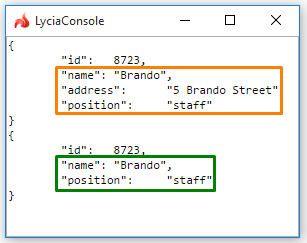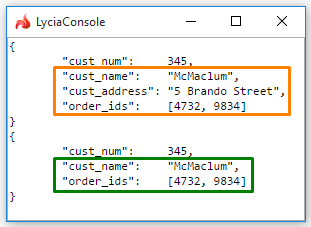example code #1
MAIN
DEFINE json_obj util.JSONObject
LET json_obj = util.JSONObject.create()
CALL json_obj.put("address", "5 Brando Street")
CALL json_obj.remove("address")
DISPLAY json_obj.get("address")
CALL fgl_getkey()
END MAIN
obtained results #1

example code #2
MAIN
DEFINE json_obj util.JSONObject
DEFINE js STRING
LET json_obj = util.JSONObject.create()
CALL json_obj.put("id", 8723)
CALL json_obj.put("name", "McMaclum")
CALL json_obj.put("address", "5 Brando Street")
CALL json_obj.put("position", "staff")
LET js = json_obj.toString()
DISPLAY util.JSON.format(js)
CALL json_obj.remove("address")
LET js = json_obj.toString()
DISPLAY util.JSON.format(js)
CALL fgl_getkey()
END MAIN
obtained results #2

example code #3
MAIN
DEFINE json_obj util.JSONObject
DEFINE cust_rec RECORD
cust_num INTEGER,
cust_name VARCHAR(30),
cust_address VARCHAR(30),
order_ids DYNAMIC ARRAY OF INTEGER
END RECORD
DEFINE js STRING
LET cust_rec.cust_num = 345
LET cust_rec.cust_name = "McMaclum"
LET cust_rec.cust_address = "5 Brando Street"
LET cust_rec.order_ids[1] = 4732
LET cust_rec.order_ids[2] = 9834
LET json_obj = util.JSONObject.fromFGL(cust_rec)
LET js = json_obj.toString()
DISPLAY util.JSON.format(js)
CALL json_obj.remove("cust_address")
LET js = json_obj.toString()
DISPLAY util.JSON.format(js)
CALL fgl_getkey()
END MAIN
obtained results #3
